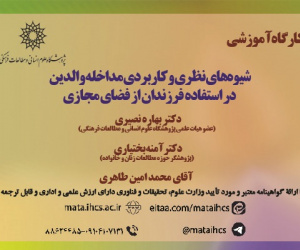رباعیّات خاقانی در سه رباعی نامه کهن (مقاله علمی وزارت علوم)
درجه علمی: نشریه علمی (وزارت علوم)
آرشیو
چکیده
خاقانی شروانی در تاریخ شعر فارسی با چکامه هایش پُرآوازه شده است. زبان سخته و پُر از اشارت های پیدا و پنهان، قصایدش را شایسته شرح و تفسیر کرده است. امّا آنچه در این گفتار در موردِ آن سخن خواهیم گفت، رباعیات اوست. قالبی که کمتر مورد بررسی پژوهشگرانِ اشعار خاقانی قرار گرفته است. موضوع مقاله حاضر بررسیِ رباعیات خاقانی در سه رباعی نامه کهن است: نزههالمجالسِ جمال خلیل شروانی (اواسطِ قرن هفتم ق.)، خلاصهالاشعار فی الرباعیاتِ ابوالمجد تبریزی (اوایلِ قرن هشتم ق.) و سفینه رباعیاتِ کتابخانه دانشگاه استانبول (اواخرِ قرن هشتم ق.). در این بررسی نظری نیز به دیگر جُنگ ها و سفینه های شعر نیز خواهیم افکند و رباعیاتِ موجود در آنها را با آنچه در سه منبع مذکور آمده، خواهیم سنجید. در پیوست مقاله، 21 رباعیِ نویافته خاقانی را آورده ایم. مأخذ این رباعیات، دست نویس های دیوان خاقانی است.Khaqani’s Rubaiyat in Three Ancient Rubāinamehs
Khaqani Shervani has become famous in the history of Persian poetry with his elegies. The difficult language, full of overt and covert allusions, has made his poems worthy of explanation and interpretation. But what we will talk about in this paper is his Rubaiyat. A format that has been less studied by scholars of Khaqani’s poetry. The subject of the present article is the study of Khaqani’s Rubaiyat in three ancient Rubāinamehs: Nuzhat al-Majālis by Jamal Khalil Shervani (mid-seventh century AH), Khulāsat al-Ash’ār fi al-Rubaiyāt by Abu al-Majd Tabrizi (early eighth century AH), and Rubaiyāt miscellany of the Istanbul University Library (late eighth century AH). In this study, we will also look at other poetic miscellanies and compare the quatrains in them with what is mentioned in the three sources mentioned. In the appendix of the article, we have included 21 newly discovered quatrains by Khaqani. The source of these quatrains is the manuscripts of Khaqani’s Divan.











